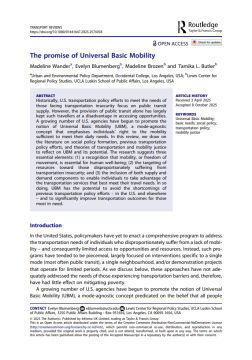Exploration and Implications of Multimodal Street Performance Metrics: What’s a Passing Grade?
Scholars, municipalities and federal agencies have proposed new measures for evaluating street performance for non-automobile modes including transit service, bicyclists and pedestrians. This is in response to the critique that the current street performance measure, traditional level of service (LOS), overemphasizes the free flow of automobile traffic while neglecting other users of the transportation system. We examine four often-cited multimodal level of service (LOS) metrics; those of the cities of Fort Collins, Colorado and Charlotte, North Carolina; metrics developed by the San Francisco Department of Public Health (BEQI/PEQI), and the multimodal LOS metrics of the 2010 Highway Capacity Manual; and explore the differences between each metric. We provide a literature review with an overview of each metric’s development and the variables used to calculate performance scores, as well as their ease of use and threats to their validity. Finally, our literature review closes by offering our critique of the metrics, focusing on how the use of single outcome metrics (even differentiated by mode) may skew our understanding of street performance by masking considerable variation among users.



